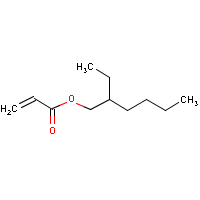2-Ethylhexyl acrylate
Agent Name
2-Ethylhexyl acrylate
Alternative Name
EHA
CAS Number
103-11-7
Formula
C11-H20-O2
Major Category
Plastics & Rubber

Synonyms
EHA; 1-Hexanol, 2-ethyl-, acrylate; 2-Ethyl-1-hexyl acrylate; 2-Ethylhexyl 2-propenoate; 2-Ethylhexylester kyseliny akrylove [Czech]; 2-Propenoic acid, 2-ethylhexyl ester; Acrylic acid, 2-ethylhexyl ester; Octyl acrylate; Mono(2-ethylhexyl) acrylate; [ChemIDplus]
Category
(Meth)acrylates
Description
Colorless liquid with a pleasant odor; [HSDB] Pale yellow liquid with a pleasant odor; [NTP]
Sources/Uses
Used as a monomer for plastics, protective coatings, and paper treatment, in copolymerization of vinyl acetate and vinyl chloride, and in the manufacture of water-based paints, adhesives, printing inks, impregnating agents, and reactive diluent/cross-linking agents; [HSDB] Used to make polymers and copolymers that are usually further processed to aqueous polymer dispersions--used mainly in adhesives and paints; Also used for coating raw materials, in the plastics industry, and as a monomer in construction industry chemicals (concentrations of 0.1-21%); [EC]
Comments
Allergic contact dermatitis reported from surgical tape; [Kanerva, p. 1741] If left on clothing, can cause reddening of skin; [CHRIS] Severly irritating to skin and eyes; [HSDB] Readily polymerized by light, heat, and peroxides; A skin, eye, and respiratory tract irritant; May cause skin sensitization; [ICSC] An eye irritant; Inhalation may cause drowsiness and convulsions; [CAMEO] Irritating but not corrosive to skin; Potential for severe respiratory irritation, based on animal studies; Studies of guinea pigs have shown moderate skin sensitization potential (with and without adjuvant); Skin sensitization also reported in humans; [EC] Readily polymerizes unless inhibited with hydroquinone or its monomethyl ester; [NTP] Danger of skin sensitization; [MAK] Inhibited with 40-100 ppm MEHQ; A skin, respiratory tract, and severe eye irritant; May cause skin sensitization; A lachrymator; [Aldrich MSDS]
Reference Link #1
Biomedical References
Exposure Assessment
MAK
5 ppm
Vapor Pressure
0.178 mm Hg
Lethal Concentration
LCLo (mouse) = 600 mg/m3
Explanatory Notes
"Danger of sensitization of skin." [MAK] VP from HSDB;
NFPA
high ambient temp required
Adverse Effects
Skin Sensitizer
Yes
Lachrymator
Yes
Neurotoxin
Other CNS neurotoxin
IARC Carcinogen
Possible (2b)
Diseases, Processes, and Activities Linked to This Agent
Diseases
Occupational diseases associated with exposure to this agent: